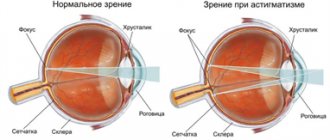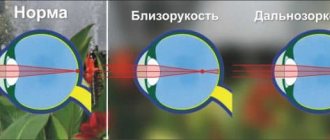There are a large number of different eye pathologies, each of which has its own fitness category, so it is hardly possible to give a definite answer to the question of whether people with poor eyesight are accepted into the army.
Only a specially organized military medical commission can make a final decision: based on an examination of the conscript and an assessment of his visual ability, a verdict is made on the fitness or, conversely, unfitness of the young man to perform military duty. VVK specialists make a conclusion in accordance with an officially approved document, which contains all the necessary information about diseases and categories corresponding to them.
Army and vision
It is common to believe that a young man of military age who has poor eyesight cannot enlist in the army for military service. The ability to serve, as well as its absence, is determined by the regulatory provision “Schedule of Diseases,” which provides all the necessary information regarding visual pathologies and the categories that they provide for. Articles 29-36 contain instructions on eye diseases; it is to these chapters that IHC specialists turn to determine the fitness category of a conscript.
Some pathologies make it possible to indisputably establish one or another category, while others, on the contrary, cause controversy and disagreement. The latter most often includes:
- Myopia is a pathology in which a person sees distant objects unclearly;
- Farsightedness – loss of visual acuity and the ability to see nearby objects;
- Astigmatism is a pathology of the visual organs associated with various deviations of the cornea, lens, or the shape of the eye itself; If you have this disease, a person cannot fully focus on objects located at any distance.
In addition to the above-mentioned diagnoses, an important factor is visual acuity. Impaired refraction of the eye does not in all cases correspond to deviations of this parameter, therefore each specific situation is considered by the members of the IHC on an individual basis.
Types of astigmatism
Depending on the characteristics of the clinical course of the disease, astigmatism is divided into several types. If a pathological process affects the cornea, doctors talk about the corneal form of the disease, and if it affects the lens, about the lenticular form. In cases where astigmatism does not have a significant effect on visual function, it is called physiological - most often this is a congenital form of the disease, and in cases of serious visual impairment they speak of a pathological variety.
If astigmatism is not treated or corrected, a person may develop strabismus.
In addition, there are several degrees and form of deviation: its severity can be mild, moderate or severe, and its form can be simple, complex or mixed.
Table. Forms of astigmatism.
| Form of astigmatism | Features of the clinical course |
| Simple | One of the meridians of the eye is characterized by myopia, and on the second there are no deviations from the norm. For this reason, correct image formation occurs only on one side. Most often, astigmatism, which occurs in a simple form, is of genetic origin and requires medical correction. |
| Complex | If myopia of varying degrees is observed on the meridians of both eyes, the disease is called complex astigmatism. It is accompanied by serious visual impairment and is observed in congenital pathologies. Lack of treatment for this type of disease can lead to amblyopia, strabismus and other complications. |
| Mixed | A complex, rare defect in which two types of impairment are observed at once - myopia and farsightedness. Not only does the light beam not focus in one place, but it also hits the right place. The disease is treated conservatively or radically |
Types of astigmatism by focal lines
If astigmatism is suspected, the patient must undergo a complete ophthalmological examination , which evaluates the condition and basic function of the visual organs. Uncomplicated forms of the disease can be corrected with glasses or contact lenses; in severe cases, the patient requires surgical intervention.
Diagnosis of astigmatism
With what kind of vision are they not enlisted in the army?
According to the “Schedule of Diseases,” each eye-related pathology has its own fitness category.
- If a conscript has any minor changes (for example, conjunctivitis or slightly reduced visual acuity, myopia up to 3 diopters, hyperopia up to 6 diopters and astigmatism up to 2 diopters), he is assigned category “A”, indicating that the young man is entering the service in the Armed Forces.
- Category “B” is given to those citizens who have been diagnosed with pathologies of the cornea, lens, optic nerve, retina, as well as initial degree glaucoma. All these are grounds for enrolling a conscript in special branches and branches of the military that do not require serious physical activity.
- O on a military ID means limited fitness for duty. Such conscripts are released from the army in peacetime, but in a dangerous military situation they are, as a rule, mobilized. The pathologies included in this group are the following: rupture or detachment of the inner membrane of the eye, pronounced diseases of the retina, lens, cornea, actively progressive glaucoma, as well as astigmatism, myopia and hypermetropia (4-6 diopters / 6-12 diopters / 8-12 diopters).
- Category “G” is assigned when a young man needs temporary exemption from military service. The basis for obtaining such a mark is the postoperative period, as well as various eye pathologies that are in the acute phase of development. A deferment from the army makes it possible to recover from surgery performed on the eyes, or to wait for remission of a particular disease of the visual organs.
- O in the World Bank speaks of the young man’s complete unfitness for military duty. Citizens who have severe visual problems are not conscripted into the army either in peacetime or in wartime. These are persons with severely reduced or completely absent vision, with myopia and hyperopia above 12 diopters, with astigmatism more than 6 diopters, glaucoma that is not in the initial stage of development, etc.
Service restrictions
- “A” - absolute suitability, without limitation of duty station;
- “B” - suitable, but not in all troops;
- “B” - unsuitable in peacetime, but subject to mobilization in martial law;
- “G”—commission for the duration of treatment;
- “D” - completely suspended from service for any period.
Point “A” includes conscripts with minor deviations in the condition of the eyelids: with conjunctivae having farsightedness + 6... + 8 diopters, myopia -3... - 6 diopters, with astigmatic progressive changes with an indicator of 2 - 4 diopters.
Mark “B” is given to young men with chronic development of eye pathologies and glaucoma.
Release for some time awaits young people with acute diseases of the visual organs, after undergoing operations. A new call will await them after recovery.
Those conscripts who have retinal detachment, glaucoma, color blindness, central and paracentral scotoma, pathologies of the function of the eye muscles, and serious injuries to the visual organs are considered unsuitable for army training.
Can they be accepted into the Air Force with poor vision in one eye?
In accordance with the law, young people who have insufficiently good vision in one eye can be drafted into the Armed Forces, however, on the condition that the visual acuity of this eye is within the acceptable values. 0.4 or more is exactly the indicator that is considered normal for entering military service.
Young men who are missing one eyeball or one eye is sighted and the other is blind are also enlisted in the army, but under the same condition: the vision of the active eye must meet acceptable standards.
There is another situation when a young person has an eyeball, but the eye is completely blind and the visual acuity of the other is 0.4 diopters.
In all of these cases, conscripts receive category “B”, meaning enrollment in the reserves with possible mobilization in wartime. Persons who do not have one eyeball or one eye is blind, and the visual acuity of the other is 0.34 diopters or less, are completely exempt from service in the Armed Forces.
What is astigmatism
Astigmatism is a disorder of the structure of the eye structures that are responsible for refraction of light and the formation of a clear image. In a healthy person, they have a smooth, even surface, but as the disease develops, it bends, bends and protrudes in different places, which leads to improper penetration of sunlight and distortion of the image that falls on the retina.
Astigmatism is a refractive error of the eye
In this case, the patient develops the following symptoms:
- decreased visual function – distortion of objects, double vision, etc.;
- rapid fatigue of the visual organs;
- tearfulness, sensation of a foreign body in the eyes;
- pain in the eyes and head.
What is eye astigmatism
The disease can be congenital or acquired - in the first case it manifests itself in infancy, and in the second it is a consequence of inflammatory or infectious processes in the organs of vision and other ophthalmological pathologies. Sometimes astigmatism does not have a negative impact on visual function, but most often it requires medical correction, otherwise it can lead to serious problems.
Astigmatism. What it is
Attention! Astigmatism is often accompanied by other pathologies of the visual system - this factor largely influences the verdict of the medical board, which decides on the suitability of a young man for military service.
Astigmatism test
What other eye diseases prevent you from joining the army?
Those young people who have the following problems with the visual organs are exempt from military service or enlisted in the reserves:
- Pathologies of the lacrimal ducts;
- Strabismus taking into account the lack of binocular vision;
- Ulcerative blepharitis;
- Glaucoma 2, 3, 4 degrees;
- Optic nerve atrophy;
- Artifakia, aphakia;
- Retinal tear or detachment;
- Congenital deviations of the eyelids (inversions or inversions, fusion of the eyelids);
- Pronounced lagophthalmos;
- Tapetoretinal abiotrophy;
- Myopia more than 6 diopters;
- Farsightedness more than 8 diopters;
- Astigmatism more than 6 diopters.
In case of significantly reduced visual acuity, suitability categories “B” and “D” are also provided. Such situations are:
- Absence of an eyeball, taking into account the visual acuity of the other eye is 0.4 or higher;
- Visual acuity of one eye is 0.3, and the other - 0.1 (or 0.09-0.4 / 0.09-less than 0.3;
- Visual acuity of both eyes is below 0.2;
- The absence of one eye, provided the clarity of the other is within 0.3 or less.
If there are burns or injuries to the sclera, cornea, iris, vitreous or ciliary body, or retina, the likelihood of not being accepted into the army is also quite high.
Glaucoma, farsightedness, color blindness.
Glaucoma, farsightedness, color blindness.
Category “D” includes conscripts with significant and severe eye diseases. In addition to astigmatism, blindness and pathology of the lacrimal ducts, this list also includes glaucoma of complexity above the initial stage.
- Glaucoma - The insidiousness of this disease is that the later it is detected, the greater the risk of complete loss of vision. Irreversible blindness occurs in a third of cases of untimely access to a medical facility. According to Article 32 of the Schedule of Diseases, conscripts with the second stage of glaucoma in both eyes, the third and fourth, are issued a military ID under point “a”. If one eye is affected (at stages 2, 3 and 4), the young man is released from service, given a military ID, and enlisted in the reserves. Category “B” is assigned with a diagnosis of “initial stage glaucoma” or “preglaucoma in both eyes or one.
- Farsightedness - A conscript who has high or moderate farsightedness in at least one eye will be released from the army. With an average degree (more than 8 diopters) the category “B” is assigned, and a high degree (over 12) – category “D”.
- Myopia - With myopia, a person cannot see objects close up, and he will be able to leave military service only if he has vision of more than 4 diopters. The reason for assigning category “B” is myopia in even one eye over 6, and category “D” - over 12 diopters.
REFERENCE! Many conscripts are interested in the question: is it possible to go to serve after vision correction?
A call in this case is quite possible: when making a decision, the medical commission will be guided by the latest medical research data. Even if the young man was initially given category “B”, next time the results of new examinations, rather than previous ones, will be taken into account.
Why is good vision important for military service?
Limitations on physical activity exist for all conscripts who have problems such as myopia, hypermetropia and astigmatism. And this is no coincidence: serious physical activity can cause the development of various complications, and the most dangerous of them is blindness.
For example, weight training increases eye pressure, which in turn leads to the development of glaucoma. It forms when fluid in the eye cannot drain naturally. During normal functioning, this is accomplished through the trabecular meshwork. However, it tends to become clogged when eye pressure increases, as a result of which the nutrition of the eye is disrupted. There is an accumulation of fluid, which puts strong pressure on the optic nerve and provokes the death of nerve endings, which ultimately becomes the main cause of vision loss.
Normal vision is of particular importance within the specifics of military service: a soldier must see well when shooting, while passing standards, while on duty, etc.
How to pass a medical examination for astigmatism
Medical examination at the military registration and
Since military registration and enlistment office employees are not always interested in granting conscripts a deferment even if there are legal grounds, young men diagnosed with astigmatism need to prepare accordingly for the event. It is necessary to undergo an examination in two independent institutions, prepare a certificate and an extract from the medical record.
Astigmatism and the army
Astigmatism is a serious visual impairment, and with such a diagnosis, most conscripts have the right to a deferment or exemption from military service. If there are legal grounds for obtaining the appropriate category, you need to exercise your right and, if necessary, defend it.
Do they take you into the army after vision correction?
Many young people decide to undergo corrective surgery to improve their vision. For those young men who still want to enroll in military service, this is the only saving chance. However, whether such conscripts are suitable for enlistment in the army is a rather controversial issue.
In some cases, after vision correction, young people who previously had problems with the visual organs are able to correct category “D” in their VB to “B”. In case of minor pathologies that can be successfully treated surgically, a second medical examination is assigned category “B”.
However, it is worth remembering that after corrective surgery, the eyes become extremely vulnerable, so experts strongly recommend avoiding serious physical exertion, not overstraining the visual organs, and especially not exposing them to various injuries. In this regard, you should think carefully about whether staying in the army will be justified and whether this factor will lead to the development of further negative consequences.
6-12 months after the operation, the young man must undergo re-examination in order to review the diagnosis and determine his suitability or unsuitability for military service.
Are people with strabismus allowed into the army: a paralytic type of the disease
This form of impairment in most cases is found in adults, because it does not directly depend on visual impairment. In such cases, one eye deviates to the side and does not take part in the visual process.
The main reasons for this violation may be:
- impairment of the optic nerves;
- muscular paralysis of the eyes;
- traumatic injuries;
- neoplasms;
- diseases of a vascular or infectious nature;
- toxic poisoning.
In such situations, the activity of the nervous system, which is responsible for muscle contraction, is disrupted. Symptoms of the disorder may include a whole range of factors. The diseased eye is limited in movement or is unable to move at all, binocular vision disappears, the head deviates to the side of the injured muscle, and dizziness is observed.
If nerve paralysis is detected, the movement of the eyeball in various directions is limited. In such situations, in order to determine the degree of fitness of a person, it is important to note in which specific direction the eye can turn. The most dangerous disorders are observed with defects of the oculomotor nerve, since it does not move in any direction.
Such defects are corrected exclusively through surgical intervention, but visual abilities are not often restored - the external defect is eliminated and the aesthetic side is restored.
Important! With a constant displacement of the eye from the main axis of vision, after a certain period of time it completely ceases to take part in visual activity.
Astigmatism and the army 2020
In medicine, astigmatism is commonly understood as a refractive error of the eye. It is for this reason that vision begins to distort and become blurry, and focusing on objects deteriorates at different distances.
Experts distinguish several types of pathology: simple, complex or mixed. However, this is not the factor that influences a conscript’s suitability for enlistment in the Armed Forces. For representatives of the VVC, the determining factor is not the type of disease, but the degree of its severity.
And there are also three of them:
- A weak degree is characterized by a value of up to 3 diopters;
- With an average refraction difference is from 3 to 6 diopters;
- It is worth talking about a strong degree if the difference between these values is determined by 6 diopters or more.
In accordance with the “Schedule of Diseases”, and more specifically with Article 34 of this provision, with a strong degree of astigmatism, the conscript is assigned fitness category “D”. The average degree of the disease requires receiving category “B” or “B”. With a violation of up to 4 diopters, a young man may be called up for military service.
When undergoing VVC if a young man has problems with the visual organs, many factors are taken into account. And we are talking not only about the presence of pathology as such, but also about the recorded facts of seeking medical help, about the condition registered with an ophthalmologist. Serious deviations are a good reason for not accepting a conscript into the Armed Forces, but in case of mild illnesses, the issue of enrollment in the army is decided on an individual basis. Most often, such situations involve the performance of military duty with certain restrictions.
Astigmatism. Concept and characteristics
Astigmatism is a visual disorder caused by distortion of the cornea or lens. The most common cases are those with a distorted cornea. The normal lens and cornea of an absolutely healthy person have a smooth surface, expressed in the form of an even sphere. If the eye is affected by astigmatism, then the surface of the cornea and lens is curved, bending or protruding in places unnatural for a spherical shape. Penetrating through damaged parts of the eye, sunlight is scattered onto the retina incorrectly. Some part of the flow goes beyond its boundaries, and the rest does not reach. Therefore, the effect of “blurring” the boundaries and parts of an object visible to a person occurs. This can be easily imagined if you look at your reflection in a tablespoon.
Astigmatism can be observed not only in adults, but also in children. Young patients usually complain of poor vision, fatigue, sharp pain in the eyes, and headache. If treatment for the disease is not started on time, the child’s performance at school and sports clubs may be called into question. Adults also often cannot focus on a specific object, so they get tired very quickly and often suffer from chronic fatigue, not to mention other unpleasant aspects. With prolonged attempts to peer at an object or inscription of interest, a split image may occur and the ability to visually estimate distance may be lost.
Reviews
Dear readers, you can leave your feedback on whether people with poor eyesight are accepted into the army in the comments, your opinion will be useful to other users of the site!
Arseny
With my poor eyesight I received category “B4”. Nevertheless, I was drafted and served as a rifleman. Much also depends on the “buyer”.
Ivan
My eyesight is not very good either, -3. I recently consulted with a person who knows a lot about this matter. In general, he said that with such indicators they could well be accepted into the ground forces. Let's see how it turns out in practice. The call is coming very soon.
Types of strabismus and categories of suitability for the army
Based on the results of the examination, the medical commission assigns a certain fitness category. Here are some of them a conscript with strabismus can receive:
- Imaginary or hidden strabismus, accompanied by non-dangerous eye diseases and a slight decrease in visual acuity. Category A - “passable”.
- Concomitant strabismus with normal vision and other mild eye pathologies. However, service in some branches of the military may be limited. Category B - “fit with minor restrictions.”
- Concomitant strabismus with normal vision, but occurring in more severe forms with complications. Category B - “fit with restrictions.”
- Serious diseases of the visual organs and the presence of monocular strabismus. Additional examinations and treatment may be prescribed, after which the conscript again needs to report to the military registration and enlistment office to undergo a medical examination. During this time, he is assigned category G - “temporarily unfit.”
- Significantly expressed ophthalmological pathologies, a strabismus angle of more than 15 degrees, an absolute absence of binocular vision. Category D – “unfit”.
Will they be accepted into the army with strabismus? The answer to this question depends on the type of strabismus and the severity of accompanying conditions - the degree of amblyopia, binocularity impairment. Only after passing a medical commission at the military registration and enlistment office is the suitability category of a conscript with strabismus for military service determined.
How to get discharged from the army based on vision
Visual acuity of both eyes is measured taking into account the ratio of any glasses or contact lenses. Good tolerance and lack of irritation are required. Conscripts who use contact lenses exchange them for glasses, in which visual acuity does not interfere with their service. A conscript is considered to be of limited fitness with sufficient visual acuity using optical products, if he can wear glasses continuously for 20 hours. Poor tolerance is difficult to prove, so it will be possible to be discharged from the army based on vision only if you have complex diseases.











